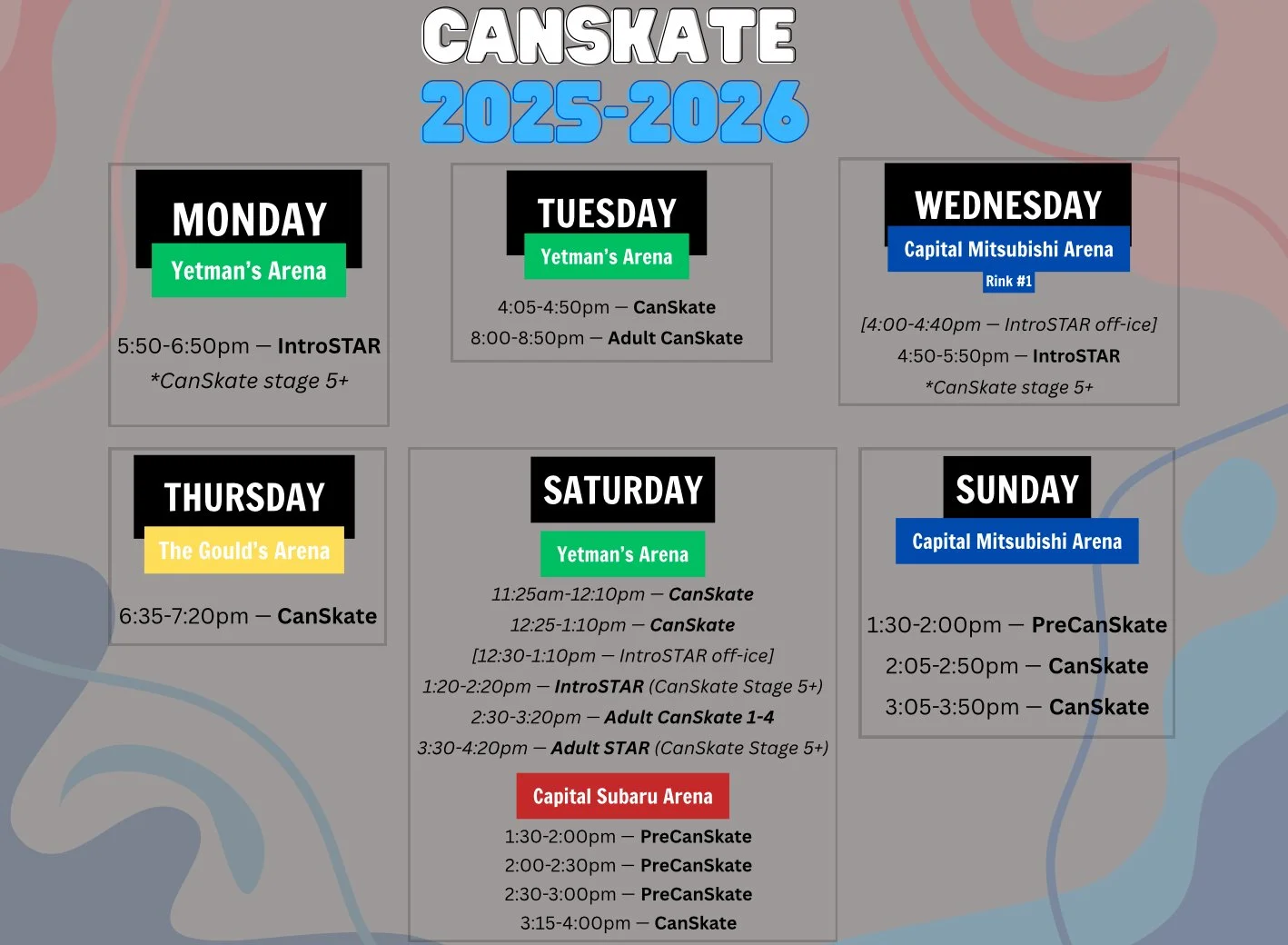
Learn to skate in St John’s, Torbay, and Goulds.
For beginners of all ages, taught in small groups by Skate Canada professional coaches. Skaters move at their own pace through levels of advancing difficult, from the basics of moving on skates to moving with speed, confidence, and power, both backward and forward.
-
45 minutes program: an 8 minute full group warm-up, 30 minutes of small group lesson time, and a 7 minute cool-down
Station-based approach teaching skills in: Agility, Balance and Control
Continuous assessment to ensure individual progress rates are supported
Report cards at the end of each season
10:1 max skater:coach ratio
Skaters may join up to halfway through Fall and Winter seasons
-
for children aged 4-8 who have never been on skates before
30 minute sessions
children graduate to CanSkate when ready
-
Ages 13 - Adult
A self-paced version of our CanSkate program, tailored to the learning styles of teens and adults
Extra help when you first get on the ice, until you are comfortable joining the group activities
Assessment days midway and near the end of each season (rather than continuous during the season)
Skater to coach ratio can vary
Come learn to skate: have fun, make friends.
Needed Equipment
-
Our insurance requires all CanSkaters to wear a CSA-approved hockey helmet!
No other helmet is acceptable!
Look for the sticker on either side of the helmet, behind the ear. If the helmet does not have an intact, readable CSA sticker, it’s not acceptable for CanSkate.
If the manufacture date is more than 5 years ago, the helmet has expired and cannot be used for CanSkate.
The helmet must be in good condition and have no missing or damaged parts
-
Recreational skates are also fine
Sharpen your skates before the first time you skate, and after every 40 hours of skating
Buying advice:
For quickly-growing children, used hockey skates will be the least expensive option, and are perfectly acceptable, particularly if the child wants to play hockey. If your child wants to figure skate, start them on figure skates.
For teens and adults, figure skates and recreational skates are easier to learn on than hockey skates. (Hockey skates are built for agility—which is another way of saying they aren’t very stable.) If you aren’t planning to play hockey, figure skates are your best choice.
Regardless of the type, skates should fit snugly at the front (your toes should just touch the front of the skate).
If the top of the foot is bulging out from the boot when you tie them, you need a deeper skate. That may mean trying a different brand. You don’t want the laces crushing the top of your foot—it can cause lasting pain (“lace bite”). Some popular brands tend to be particularly hard on wide feet and high arches.
Skates won’t be super comfortable until you get used to them, but they really shouldn’t hurt your foot. If they do, you probably need a different skate.
-
Gloves or mittens are essential
Warm layers that allow movement
Nothing trailing on the ground
-
A cloth to dry off blades
Hard skate guards to wear while walking around
Soft guards to protect blades in transit. These will also absorb moisture to reduce risk of rusting blades.
Skills Reference
If you are curious, here is a full list of skills we teach, with links to Skate Canada’s skill video library.
Balance (🎦)
-
Forward skating
Forward two-foot glide
Forward two-foot sit glide
-
Forward sculling
Forward two-foot to one-foot glide
Forward push/glide sequence
Forward one-foot glide with speed
-
Forward stationary blade push
Forward two-foot slalom
Forward circle thrusts
Walking crosscuts
Forward two-foot to one-foot curve glide
-
Forward crosscuts
Forward inside giant slalom
Forward outside giant slalom
Forward lunge
Forward spiral
Drop-down drill
Forward V start
-
Forward crossovers figure 8
Forward inside edges
Forward push/glide Sequence
Inside spread eagle
Forward one-foot slalom
Running lateral crossovers
Forward perimeter skating with jumps
-
Forward power crosscuts
Forward outside edges
Forward one-foot slalom
Forward one-foot sit glide
Forward spiral
Forward crossover acceleration
Forward perimeter skating with crosscuts
Forward perimeter skating with side stops
Control (🎦)
-
Backward skating
Backward two-foot glide
-
Forward stop
Backward two-foot sit glide
Backward two-foot to one-foot glide
Backward push/glide sequence
-
Forward stop with speed
Backward sculling
Backward two-foot to one-foot glide
Backward push/glide sequence
Backward one-foot glide
-
Backward stop
Backward circle thrusts or pumps
Backward two-foot slalom
Backward one-foot glide with speed
Sustained forward one-foot glide
Speed drill # 1
-
Forward two-foot side stop
Backward stop with speed
Backward crosscuts
Backward inside giant slalom
Backward push/glide sequence
Backward spiral
Speed drill # 2
-
Forward one-foot side stop
Forward two-foot side stop with speed
Backward outside giant slalom
Backward crosscuts figure 8
Backward perimeter skating with crosscuts
Backward one-foot slalom
Backward one-foot spin
Speed drill # 3
Agility (🎦)
-
Stationary two-foot jump
Forward skating perimeter of ice surface
-
Forward two-foot turn
Backward two-foot turn
Forward two-foot jump
Forward 180° glide turn
-
Forward two-foot quick turn
Backward two-foot quick turn
Forward 360° step turn
Backward two-foot jump
Fast forward perimeter skating
-
Forward one-foot turn
Backward 360° step turn
Forward to backward two-foot jump
Backward to forward two-foot jump
Two-foot spin
Two-foot sit spin
-
Forward one-foot turn
Forward 360° glide turn
Forward to backward one-foot turn
Forward power jump
One-foot spin
Alternating foot spin
Forward tight glide turns
-
Forward C step
Backward C step
Two-foot multi turns
Rotating power jump
Backward toe-assisted jump
Backward 360° two-foot jump
Forward one-foot spin with spiralling entry
Forward two-foot reverse pivot turn



